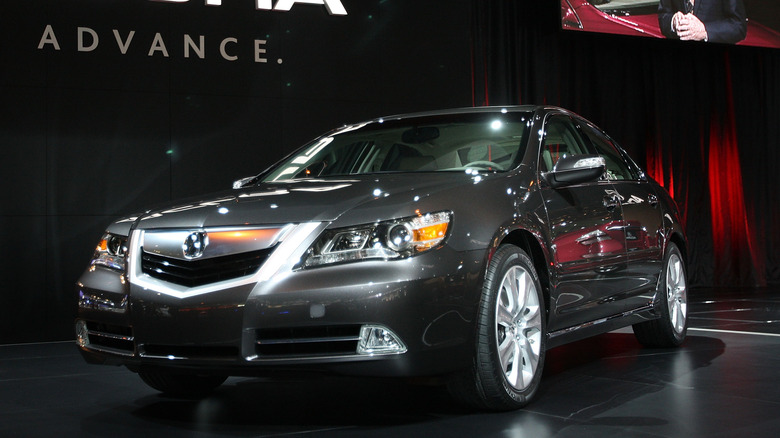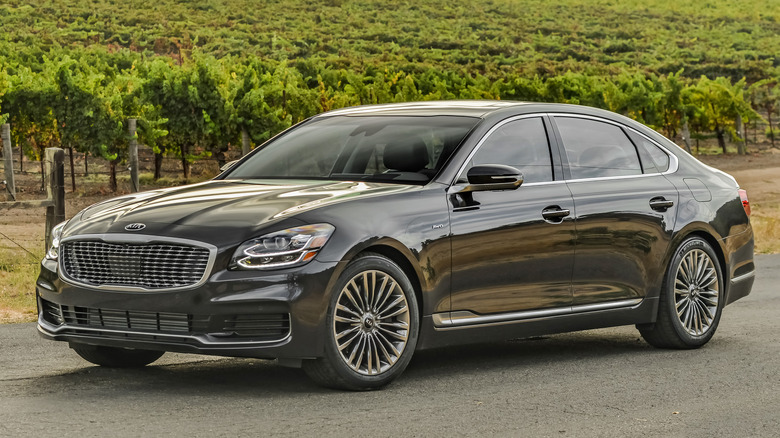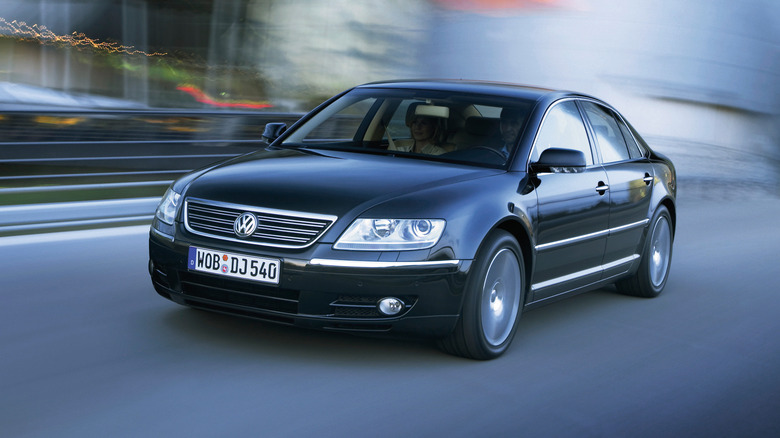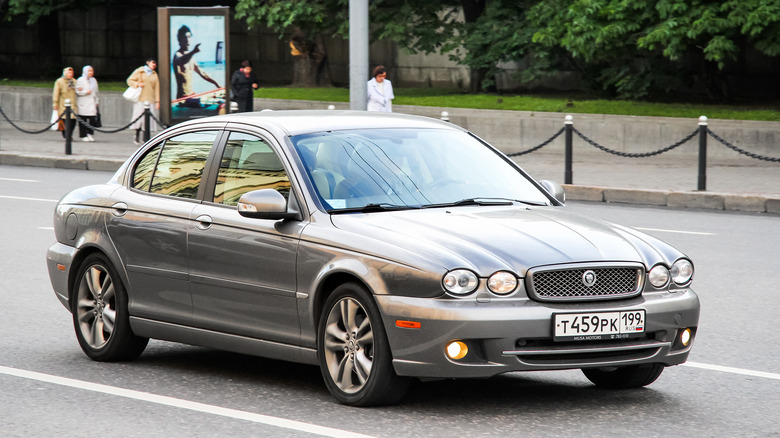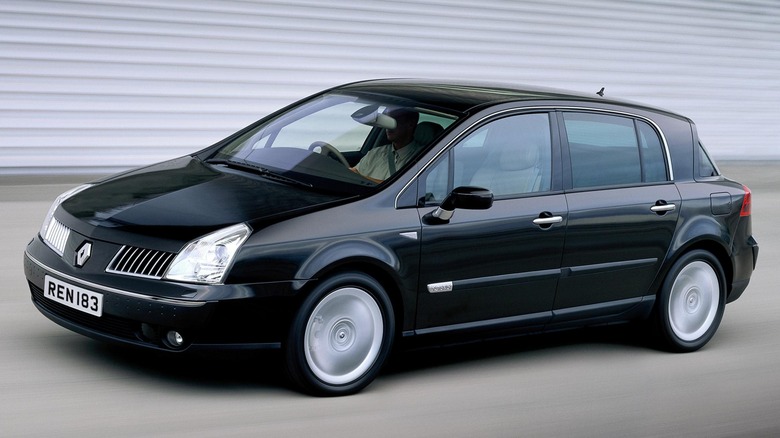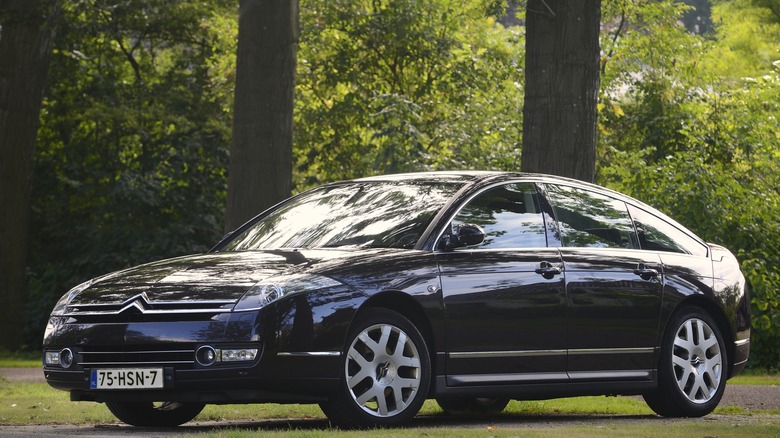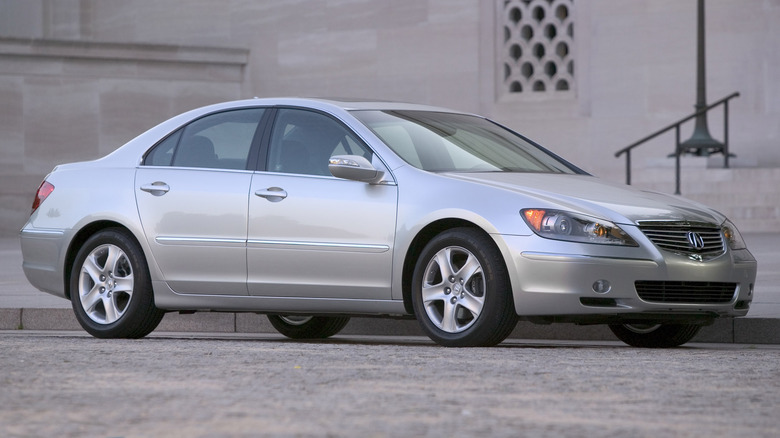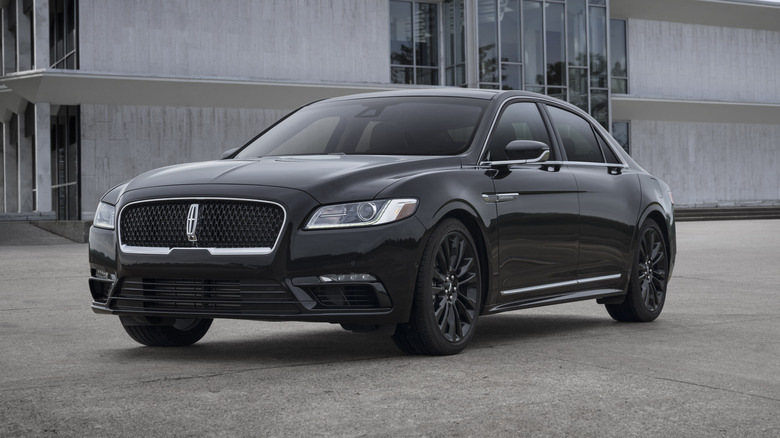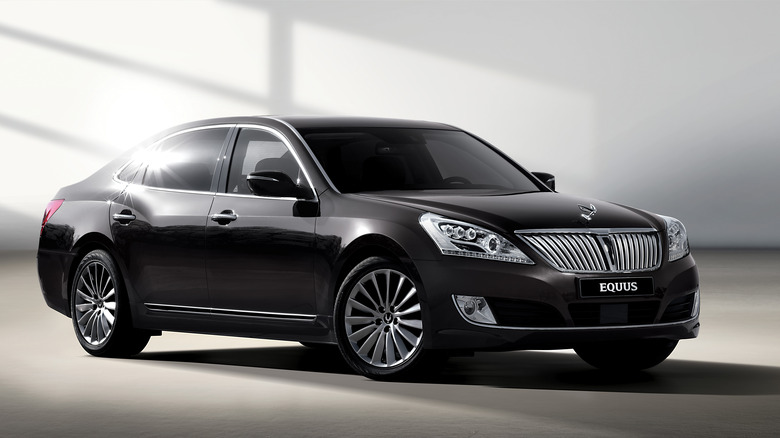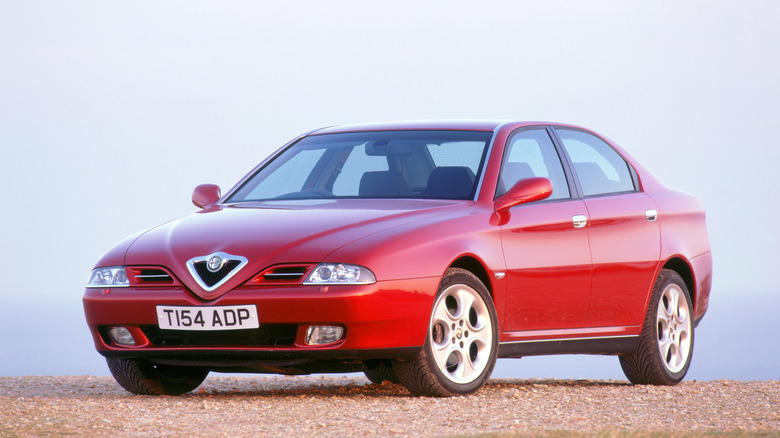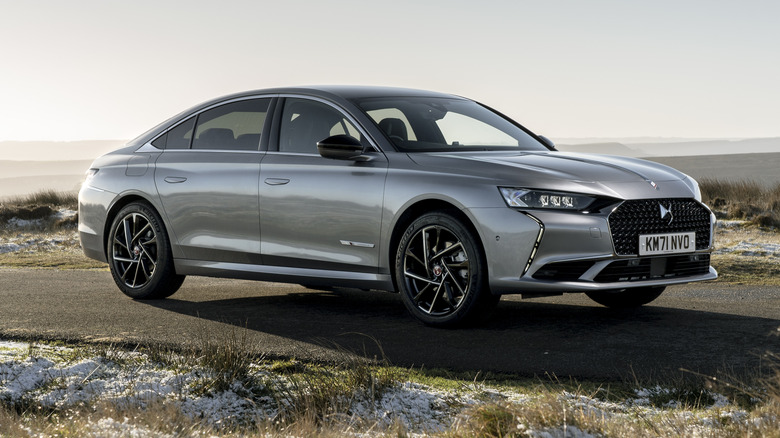10 Underdog Luxury Cars That Shouldn't Have Flopped
Luxury cars. The very best that the automaker does, where money is no object, and no feature is too crazy or too luxurious. Whether they're SUVs or not, luxury cars are still doing well, and they're still very important for buyers who can conjure up the cash for such a vehicle, while also representing a curious buy on the used market — a curious buy that comes with several massive asterisks, mind you. There is one other quite important aspect to know about the world of luxury cars: it's almost entirely dominated by the Germans.
BMW, Mercedes-Benz, and Audi have all established themselves as the leaders of the segment, and the primary choice for all successful businessmen the world over. This has been the case for decades, as those names carry a lot of weight and bragging rights, for better and for worse. As a result of the outright dominance of German brands in the luxury segment, no matter how hard some automakers tried — and they really did — they simply couldn't dethrone the Germans. It's really a shame, because some of these total flops actually had quite a bit to offer, and in some aspects, they even managed to beat the Germans at their own game. Regardless, they couldn't beat the Germans in the only place that matters: sales.
Kia K900
25 years ago, the only reason why anyone would ever buy a Kia was because it was cheap. For those earlier Kia vehicles, there was a price to pay for being so cheap, and that price would be paid by the owner. Things couldn't be more different nowadays, as Kia has rocketed to the top of ... well, everything. So about a decade ago, Kia decided to shoot for the stars by introducing a full-size luxury sedan to the North American market: the K900.
The K900 began production in 2012, and on paper, it had all the right ingredients for a fantastic luxury sedan. For starters, it was one of the only vehicles in Kia's history to have eight cylinders. Along with the standard fare of V6 engines, you could spec the K900 with a pretty substantial 5.0-liter V8 putting out 429 hp. It also included all of the luxury features you might expect, and it was all wrapped up in a classy, but understated body. It was a little anonymous, but at the same time, it didn't cause exclamations of disgust like some more recent luxury sedans might do.
Despite all of its decent qualities, the K900 was pretty much destined for failure, and you'll never guess why. While Kia has won the hearts of so many consumers, nobody was willing to take a second glance at a luxury sedan with a Kia badge. The brand cachet, which is endlessly important in this segment, just wasn't there.
Volkswagen Phaeton
The 2000s were a fantastic era for automobiles, as that was not only the decade in which we saw some of the last analog sports cars, but also the last hurrah of truly insane, powerful engines. Easily one of the craziest automotive lineups of this era came from Volkswagen, which decided to tackle the premium segment properly with the Phaeton. After the even more ridiculous Passat W8 failed to do the same, all the money was on the Phaeton.
Sure, the Phaeton might have resembled a larger, more dressed up Passat, but that's being unkind. The Phaeton was based on the same platform that underpinned the Bentley Continental GT, and it had one car set firmly in its crosshairs: the S-Class. Volkswagen decided to give the Phaeton every single luxury feature available at the time, as well as pay attention to the tiniest of details. You could also get the Phaeton with some ridiculous powertrains, including the same W12 from the aforementioned Continental and even a V10 diesel. Yes, a V10 diesel.
So what went wrong with Volkswagen's most luxurious car? A Volkswagen badge certainly carries a lot more weight than Kia, and that was especially the case in the 2000s. Unfortunately, the Phaeton's resemblance to the Passat did not work any wonders for its appeal, plus Volkswagen already sold two other no-holds-barred luxury sedans: the Audi A8 and, later on, the Bentley Continental Flying Spur. Even crazier, the Phaeton almost came back after it was killed.
Jaguar X-Type
Platform sharing is a very common practice in the automotive industry. If one automaker owns multiple car brands, you can be certain that each one of those brands will have their own take on a similar vehicle. The Jaguar X-Type was, in a lot of ways, a bad example of badge engineering. When the X-Type debuted in 2001, Jaguar was one of the four companies comprising Ford's Premier Automotive Group, alongside Volvo and Aston Martin.
Digging underneath the controversial early 2000s Jaguar styling makes it clear that the X-Type is a very close relative to the Mk3 Ford Mondeo, a much cheaper and much less luxurious vehicle. Aside from the unique styling, the X-Type didn't do a whole lot to differentiate itself, except for maybe a few nicer trimmings and features. As you might expect, the parts bin rummaging was pretty major, and that includes most of the powertrains under the hood. Interestingly, the Queen owned an X-Type wagon.
This is not to say the X-Type was a bad car, because it was a pretty good compact luxury sedan. Good enough to dethrone the all-conquering 3 Series and C-Class? Absolutely not. Jaguar's reputation for patchy reliability and for losing $50 in value for every 0.3 mi covered also didn't help here.
Renault Vel Satis
The French luxury car rulebook is quite different than the one used by most other global automakers. Sure, French luxury cars will offer good amounts of opulence and extra features, but they also throw in one more very important feature: quirkiness. Those who know French cars know that making them simple and conventional simply doesn't work; they have to be totally unorthodox. That is certainly the case with the Renault Vel Satis.
At first glance, the styling doesn't make any sense. The bottom half of the exterior looks like a conventional sedan, but the top half and greenhouse area appear to be plucked from a minivan. That was done intentionally to increase interior room. That's quite an important aspect of a luxury car, though it's important to note that the Vel Satis didn't offer seven seats: it was just an oversized hatchback masquerading as a big waftmobile.
The powertrains were pretty standard fare, some four cylinders and some V6s, but one option stands out above the rest: the 3.5-liter gasoline V6. That engine carries the code VQ35DE, which you may have heard of. Despite the Vel Satis' lovable break from convention and luxury appointments, it never struck a chord with the majority of luxury car buyers. Being a massive, massive fan of quirky French cars was a requirement to purchase one. Speaking of which...
Citroën C6
One of the undisputed kings of quirky French luxury cars is the Citroën C6. Many consider it the last true Citroën, and not just because it was one of the last ones to feature the innovative hydropneumatic suspension system, named Hydractive in this case. The C6 was also the last Citroën sedan to proudly wear and modernize some of the unique styling traits of its predecessors like the CX and DS, such as the concave rear window, the rear quarter windows, and the general shape.
The C6 launched in 2005, with the hopes of providing a French alternative to your average Joe 5 Series and E-Class. Considering that Citroën's lineup in 2005 was painfully normal, the C6 came out of nowhere, and it was a reminder of what the automaker was once about and what it was good at. The C6 provided all the luxury features and quality appointments that you expect in a luxury car, but it also drew a line in the sand so deep it reached below ground level in one area: comfort.
Despite it being a return to form for the luxury Citroën, the C6 couldn't survive the massive German tides in this segment. Production ended in 2012, though in recent times, people have started to appreciate the C6 a lot more. As a result, it's firmly on its way to become a classic car. Shame it's plagued by some daunting reliability issues.
Acura RL / Honda Legend
Believe it or not, Toyota was not the first to arrive in North America with a new luxury brand. That was Honda, who introduced Acura in 1986. One of the first models to launch from this new brand was the Legend, which was still called a Honda in other markets. It was the largest, most luxurious sedan from the automaker up to that point, and it came with something new and very unusual: a V6 powertrain.
The Legend would eventually be renamed the Acura RL in North America, but it was still called the Legend in most other foreign markets. The final RL (before the RLX came along), introduced for the 2005 model year, was rather special. As well as offering a plethora of luxury features, the Legend/RL was also aimed at the more enthusiastic luxury car buyer, featuring a high-revving naturally-aspirated V6 and standard AWD.
Even though the RL/Legend had a lot to offer, the styling wasn't exactly crowd-pleasing, and the same could be said of the interior design. Did we mention that this market is dominated by the Germans and not much can be done to change that? Eventually, Acura abandoned the full-size luxury sedan segment altogether, although it must be said, Acura stuff today is really rather good.
Lincoln Continental
Not too long ago, Lincoln stood out in the luxury car market by offering the American rendition of luxury: massive, wafty sedans that whimpered if you chucked them hard into a corner, and gauge clusters with massive, easily readable fonts — for the target audience, of course. A few years ago, Lincoln wanted to become properly competitive in the luxury car market, where old-school American luxury simply doesn't cut it. One of the frontrunners of this offensive was the surprisingly good Continental.
The ninth generation car bowed out in 2002, and 2017 saw the release of an all-new Continental, reviving the nameplate that lay dormant for 15 years. The exterior was understated, the powertrains were smooth and strong, and the luxury features were on point. Lincoln even went all-out to honor its heritage and introduced a limited production Continental with rear coach doors, quite simply named the Continental Coach Door Edition.
Despite the Continental's recipe being pretty well measured, things did not go well. At all. Usually, left-field luxury sedans like the Continental last a little longer than four model years on the market. Would you believe, that is exactly how many years the Continental soldiered on for, biting the dust in 2020. By the end of the production run, the Continental's sales numbers only had four digits.
Hyundai Equus
It wasn't just the Kia side of the Hyundai Motor Group that brought their luxury sedan to the Western world. Hyundai decided to join in on the action with the K900's close relative, the Equus. The original Equus was a joint project between Hyundai and Mitsubishi, and while Korea ate it up, the original Equus never really saw any Western dealership lots. That changed with the second generation car, introduced in 2009, which wore a much snazzier suit than the rather plain looking first-gen vehicle.
Like the K900, the Equus also offered the same Tau V8 engine, but in two different sizes. It also sensibly moved to a RWD platform, and it upped the quality and the features in just about every aspect, being the first Hyundai vehicle to offer air suspension and adaptive damping, while the interior was equipped with niceties such as ventilated rear seats. As with so many left-field luxury sedans, one big differentiating factor that the Equus had going for it was value, undercutting the majority of its more established rivals.
But no amount of persuasion was enough to get most luxury car buyers to opt for the Equus before it bowed out in 2016. Today, the Equus remains a curious piece of Hyundai's history, and it also remains one of the cheapest used luxury cars on the market. Sadly, there's a very high chance that the ownership experience won't be entirely trouble-free.
Alfa Romeo 166
Jeremy Clarkson once said that you can't be a proper gearhead until you have owned an Alfa Romeo. That's all well and fine, except that most gearheads didn't want to own an Alfa Romeo. It was never made clear what the reasons were, but it might have something to do with reliability. When Alfas work, they work amazingly well, and the 166 is one of many examples. Launched in the late '90s to replace the celebrated 164, the 166 was once again hunting for E-Class and 5 Series blood.
It was still front-wheel drive, but it made improvements all across the board, particularly in the luxury department. It's also a gorgeous car, like most Alfa Romeos. The tiny headlights of the early 166 versions weren't the best, but the 2003 facelift brought the 166 up to date, and it was all the better for it. There were also some excellent powertrains on offer, including a torquey five-cylinder turbo diesel, and of course, the Busso V6.
No matter what Alfa Romeo does, their reputation for reliability never trails too far behind. No matter how good the car is, there is always that one asterisk that it's an Alfa and it will break eventually. The 166's depreciation curve was incredibly steep, and its most loyal customer base ended up being the most dedicated of Alfa Romeo enthusiasts.
DS 9
After seeing minor success with its DS lineup of models, Citroën decided to take a brave step into an unexplored frontier: they spun off DS into its own luxury sub-brand. Crossovers are very much a part of the lineup as you might expect, but there's also a mid-size sedan. Stellantis' dedication here is completely admirable: a mid-size luxury sedan from a totally new sub-brand in a world dominated by mostly affordable crossovers. The DS 9 is definitely an odd one out here, but it does have plenty to offer.
Based on the Peugeot 508, the DS 9 is moved along by a selection of punchy hybrid powertrains, the punchiest of which offers up 360 hp and AWD, thanks to the rear-mounted electric motors. Tributes to the iconic DS are sprinkled around the bodywork, particularly in the roof-mounted rear turn signals. Ultimately, however, it's nowhere near as quirky and interesting as people have come to expect from a French luxury car.
Sportiness isn't really something you can find in the DS 9, either. It's primarily set up for comfort. While that can be considered a good thing, the more dynamic competition will certainly run rings around it. It's pretty much guaranteed that the DS 9 is not too long for this world, but we admire DS Automobiles' dedication to give the French luxury sedan one last whirl.
